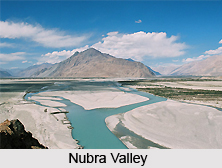 Until 1994, the North of Leh was inaccessible to tourists and it remained unexplored till the nineteenth century. The awe-inspiring Nubra Valley, explores the world`s highest stretch of motorable road as one crosses the Khardung La. These places can be visited by taking a seven-day permit. Seven day visit is sufficient to explore the insight beauties of the deserted territory, Gompas and trekking in the mountains. The valley`s mountain backbone looks east to the Nubra river and west to the Shyok river which meet in midst of silver-grey sand bank and rocky fields. To the north and east, the mighty Karakoram Range traces the Indian border with China and Pakistan. In the valley dust storms are common, thrashing sand and trash. Before this region passed into executive hands of Leh, Nubra`s ancient king`s ruled this place from the palace of Charasa, situated in a remote area in the small hill opposite Sumur, which is the home to the valley`s principal monastery. Further, ascending upwards beyond the Nubra River is located Panamik. By the neighbouring Shyok River, Diskit observes a hillside Gompa and another place Hundur is renowned for its strange double-humped herd of Bactrian camels. The route from North to Nubra is a steep and rough road but because of its significance as a military route towards the battlefields of the Siachen Glacier, this road is kept open all throughout the year, although conditions can be disloyal anytime.
Until 1994, the North of Leh was inaccessible to tourists and it remained unexplored till the nineteenth century. The awe-inspiring Nubra Valley, explores the world`s highest stretch of motorable road as one crosses the Khardung La. These places can be visited by taking a seven-day permit. Seven day visit is sufficient to explore the insight beauties of the deserted territory, Gompas and trekking in the mountains. The valley`s mountain backbone looks east to the Nubra river and west to the Shyok river which meet in midst of silver-grey sand bank and rocky fields. To the north and east, the mighty Karakoram Range traces the Indian border with China and Pakistan. In the valley dust storms are common, thrashing sand and trash. Before this region passed into executive hands of Leh, Nubra`s ancient king`s ruled this place from the palace of Charasa, situated in a remote area in the small hill opposite Sumur, which is the home to the valley`s principal monastery. Further, ascending upwards beyond the Nubra River is located Panamik. By the neighbouring Shyok River, Diskit observes a hillside Gompa and another place Hundur is renowned for its strange double-humped herd of Bactrian camels. The route from North to Nubra is a steep and rough road but because of its significance as a military route towards the battlefields of the Siachen Glacier, this road is kept open all throughout the year, although conditions can be disloyal anytime.



















